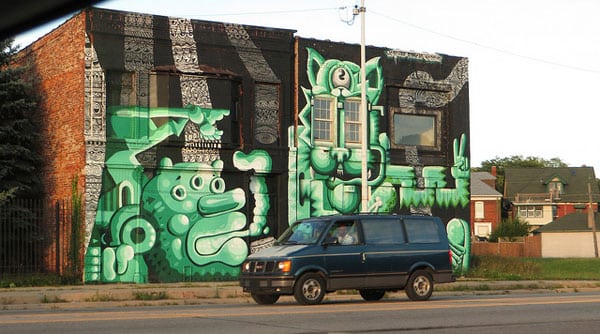
June 21, 2018; Curbed Detroit
In several Northwest Detroit neighborhoods, a community-led revitalization effort is underway that centers on leveraging existing community assets, authentically listening to community input, and using a framework developed in partnership with residents that emphasizes their priorities while defining common routes for shared investment.
This process and the emerging results are led by Sinai Grace Guild Community Development Corporation (SGGCDC) and should prompt nonprofits engaged in similar community revitalization efforts to explore and learn from the framework, as it represents a truly community-driven process that is inclusive and stands in contrast to the more traditional top-down approaches that have become far too common in revitalization in general.
(While this newswire is too short to discuss the long and sometimes treacherous history of revitalization in Detroit, it is important to note the historical context of Detroit’s community development efforts, including the Grand Bargain, the philanthropic sector’s role, and the important democratic underpinnings involved in revitalization overall. For reference and an excellent overview of this background, see NPQ’s 2016 article by Rick Cohen.)
This iteration of revitalization in northwest Detroit was initiated in part by Sinai-Grace Hospital Northwest, which recently underwent a $77 million renovation, and as part of the process engaged Enterprise Community Partners to explore how the renovation and investment could serve as a catalyst for community revitalization. Through this forward-thinking approach, Sinai-Grace served as an exemplary example of how anchor institutions can serve as conveners in weaving community networks and ensuring that voices that are typically not included are considered.
The areas upon which SGGCDC is focused comprise the neighborhoods just north of Grandmont-Rosedale, specifically Crary/St. Marys, College Park, Winship, Hubbell-Puritan, Belmont, Bethune, and Shulze. SGGCDC is a group effort made up of citizens, along with businesses and institutions, in the neighborhoods involved. According to the Northwest Detroit Neighborhood Revitalization Vision and Strategic Framework, which emerged from a series of community conversations, the neighborhoods impacted by these efforts are diverse and face barriers to being included in traditional revitalization efforts, and hence this process aims to foster a more equitable approach.
Of the 36,000 residents in the area, 96 percent are African American, 19 percent have at least one disability, 36 percent live in poverty, and 21 percent are unemployed. In addition, other issues such as housing and financial insecurity are pervasive. Using the Enterprise Community Partners Opportunity 360 Measurement Report, 75 percent of the renters in these neighborhoods are housing cost burdened, 31 percent of the occupied housing lacks adequate kitchen or plumbing, and an estimated 2,600 residential property owners are facing foreclosure.
Sign up for our free newsletters
Subscribe to NPQ's newsletters to have our top stories delivered directly to your inbox.
By signing up, you agree to our privacy policy and terms of use, and to receive messages from NPQ and our partners.
Despite these characteristics, which some community development professionals would signal as the deficits that define the community, the neighborhoods SGGCDC works with are rich in cultural, institutional, religious, and public assets that are driving the revitalization process. These assets are featured front and center throughout the process SGGCDC implemented to create the community revitalization framework, and the process is worth noting.
Over a five-month period, SGGCDC convened a series of four public forums designed to create the framework for revitalization that emphasized community assets and provided an opportunity for residents and neighborhood advocates to participate. These four workshops included:
- Designing our neighborhoods using neighborhood reconnectivity to parks and open spaces, housing, and commercial opportunities
- Designing our neighborhoods’ future through mapping community assets, exploring improvements for each neighborhood and discussing reinvestment plans
- Discussing scenarios for future development and determining evaluation criteria to assess
- Prioritizing over 100 stakeholder-generated ideas and identifying implementation partners
Throughout the workshops, issues, concerns, and areas for improvement were classified in broad areas, including public safety, greenways, parks, streetscape, commercial corridors, housing, education, and other. From these broad categories, the group generated suggestions and ideas for every neighborhood in the area, and seven strategic focus areas emerged: 1) Commercial and economic development, 2) Economic security and wealth-building, 3) Residential stabilization and growth, 4) Open space and parks, 5) Mobility and sustainability, 6) Community building and enhanced quality of life, and 7) Leadership and neighborhood capacity development.
Each of the strategic areas has several projects and initiatives that originated from the community and participants in the workshops. Together, the seven focus areas generated several unique investment opportunities ranging from business retention and expansion, to workforce development concepts, to housing rehabilitation, and others that provide a community-embraced revitalization plan that has garnered the support and attention from various sectors.
SGGCDC and the activities it has initiated is a great example of effective community engagement being paired with cross-sector collaboration to create bottom-up community development. Given the broad range of partners engaged, the revitalization effort has a wealth of community resources to draw upon, as each partner has unique assets, skills, and talents. Partners have leveraged these resources to make significant progress. One example is Enterprise Community Partners’ work with other CDCs in the area to provide capacity building and technical assistance. In partnership with the City of Detroit, the area hosted Enterprise’s 7th Annual Affordable Housing Design Leadership Institute, an outcomes-based design institute to teach development and design leaders new skills and share best practices and innovations. In addition, Enterprise has provided funding to strengthen the capacity of CDCs and other partners have provided additional resources.
As revitalization in Detroit gains attention, and efforts such as the Strategic Neighborhood Fund increase in recognition and funding, it is important to acknowledge community-led efforts like SGGCDC as promising practices that thoughtfully engage communities in crafting equitable futures through ongoing engagement and participation in the revitalization process.—Derrick Rhayn












